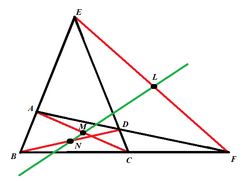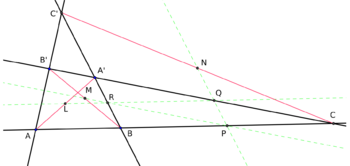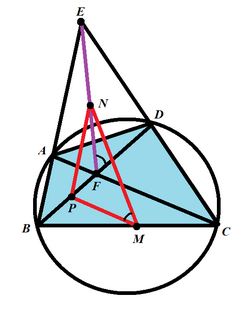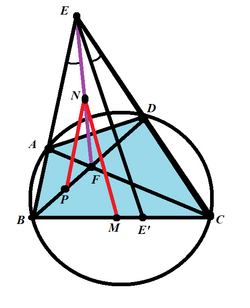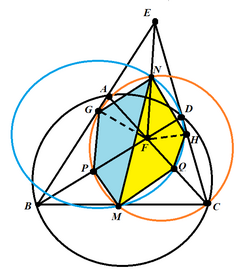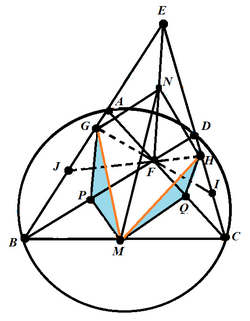Newton–Gauss line
In geometry, the Newton–Gauss line (or Gauss–Newton line) is the line joining the midpoints of the three diagonals of a complete quadrilateral.
The midpoints of the two diagonals of a convex quadrilateral with at most two parallel sides are distinct and thus determine a line, the Newton line. If the sides of such a quadrilateral are extended to form a complete quadrangle, the diagonals of the quadrilateral remain diagonals of the complete quadrangle and the Newton line of the quadrilateral is the Newton–Gauss line of the complete quadrangle.
Complete quadrilaterals
Any four lines in general position (no two lines are parallel, and no three are concurrent) form a complete quadrilateral. This configuration consists of a total of six points, the intersection points of the four lines, with three points on each line and precisely two lines through each point.[1] These six points can be split into pairs so that the line segments determined by any pair do not intersect any of the given four lines except at the endpoints. These three line segments are called diagonals of the complete quadrilateral.
Existence of the Newton−Gauss line
It is a well-known theorem that the three midpoints of the diagonals of a complete quadrilateral are collinear.[2] There are several proofs of the result based on areas [2] or wedge products[3] or, as the following proof, on Menelaus's theorem, due to Hillyer and published in 1920.[4]
Let the complete quadrilateral ABCA'B'C' be labeled as in the diagram with diagonals AA', BB', CC' and their respective midpoints L, M, N. Let the midpoints of BC, CA', A'B be P, Q, R respectively. Using similar triangles it is seen that QR intersects AA' at L, RP intersects BB' at M and PQ intersects CC' at N. Again, similar triangles provide the following proportions,
- [math]\displaystyle{ \frac{\overline{RL}}{\overline{LQ}} = \frac{\overline{BA}}{\overline{AC}}, \quad \frac{\overline{QN}}{\overline{NP}} = \frac{\overline{A'C'}}{\overline{C'B}}, \quad \frac{\overline{PM}}{\overline{MR}} = \frac{\overline{CB'}}{\overline{B'A'}}. }[/math]
However, the line △AB'C' intersects the sides of triangle △A'BC, so by Menelaus's theorem the product of the terms on the right hand sides is −1. Thus, the product of the terms on the left hand sides is also −1 and again by Menelaus's theorem, the points L, M, N are collinear on the sides of triangle △PQR.
Applications to cyclic quadrilaterals
The following are some results that use the Newton–Gauss line of complete quadrilaterals that are associated with cyclic quadrilaterals, based on the work of Barbu and Patrascu.[5]
Equal angles
Given any cyclic quadrilateral ABCD, let point F be the point of intersection between the two diagonals AC and BD. Extend the diagonals AB and CD until they meet at the point of intersection, E. Let the midpoint of the segment EF be N, and let the midpoint of the segment BC be M (Figure 1).
Theorem
If the midpoint of the line segment BF is P, the Newton–Gauss line of the complete quadrilateral ABCDEF and the line PM determine an angle ∠PMN equal to ∠EFD.
Proof
First show that the triangles △NPM, △EDF are similar.
Since BE ∥ PN and FC ∥ PM, we know ∠NPM = ∠EAC. Also, [math]\displaystyle{ \tfrac{\overline{BE}}{\overline{PN}} = \tfrac{\overline{FC}}{\overline{PM}} = 2. }[/math]
In the cyclic quadrilateral ABCD, these equalities hold:
- [math]\displaystyle{ \begin{align} \angle EDF &= \angle ADF + \angle EDA, \\ &= \angle ACB + \angle ABC, \\ &= \angle EAC. \end{align} }[/math]
Therefore, ∠NPM = ∠EDF.
Let R1, R2 be the radii of the circumcircles of △EDB, △FCD respectively. Apply the law of sines to the triangles, to obtain:
- [math]\displaystyle{ \frac {\overline{BE}}{\overline{FC}}=\frac {2R_1\sin \angle EDB}{2R_2\sin \angle FDC}=\frac {R_1}{R_2}=\frac {2R_1\sin \angle EBD}{2R_2\sin \angle FCD} = \frac{\overline{DE}}{\overline{DF}}. }[/math]
Since BE = 2 · PN and FC = 2 · PM, this shows the equality [math]\displaystyle{ \tfrac{\overline{PN}}{\overline{PM}} = \tfrac{\overline{DE}}{\overline{DF}}. }[/math] The similarity of triangles △PMN, △DFE follows, and ∠NMP = ∠EFD.
Remark
If Q is the midpoint of the line segment FC, it follows by the same reasoning that ∠NMQ = ∠EFA.
Isogonal lines
Theorem
The line through E parallel to the Newton–Gauss line of the complete quadrilateral ABCDEF and the line EF are isogonal lines of ∠BEC, that is, each line is a reflection of the other about the angle bisector.[5] (Figure 2)
Proof
Triangles △EDF, △NPM are similar by the above argument, so ∠DEF = ∠PNM. Let E' be the point of intersection of BC and the line parallel to the Newton–Gauss line NM through E.
Since PN ∥ BE and NM ∥ EE', ∠BEF = ∠PNF, and ∠FNM = ∠E'EF.
Therefore,
- [math]\displaystyle{ \begin{align} \angle CEE' &= \angle DEF - \angle E'EF, \\ &= \angle PNM - \angle FNM, \\ &= \angle PNF = \angle BEF. \end{align} }[/math]
Two cyclic quadrilaterals sharing a Newton-Gauss line
Lemma
Let G and H be the orthogonal projections of the point F on the lines AB and CD respectively.
The quadrilaterals MPGN and MQHN are cyclic quadrilaterals.[5]
Proof
∠EFD = ∠PMN, as previously shown. The points P and N are the respective circumcenters of the right triangles △BFG, △EFG. Thus, ∠PGF = ∠PFG and ∠FGN = ∠GFN.
Therefore,
- [math]\displaystyle{ \begin{align} \angle PGN + \angle PMN & = (\angle PGF + \angle FGN) + \angle PMN \\[4pt] & = \angle PFG + \angle GFN + \angle EFD \\[4pt] &= 180^\circ \end{align}. }[/math]
Therefore, MPGN is a cyclic quadrilateral, and by the same reasoning, MQHN also lies on a circle.
Theorem
Extend the lines GF, HF to intersect EC, EB at I, J respectively (Figure 4).
The complete quadrilaterals EFGHIJ and ABCDEF have the same Newton–Gauss line.[5]
Proof
The two complete quadrilaterals have a shared diagonal, EF. N lies on the Newton–Gauss line of both quadrilaterals. N is equidistant from G and H, since it is the circumcenter of the cyclic quadrilateral EGFH.
If triangles △GMP, △HMQ are congruent, and it will follow that M lies on the perpendicular bisector of the line HG. Therefore, the line MN contains the midpoint of GH, and is the Newton–Gauss line of EFGHIJ.
To show that the triangles △GMP, △HMQ are congruent, first observe that PMQF is a parallelogram, since the points M, P are midpoints of BF, BC respectively.
Therefore,
- [math]\displaystyle{ \begin{align} & \overline{MP} = \overline{QF} = \overline{HQ}, \\ & \overline{GP} = \overline{PF} = \overline{MQ}, \\ & \angle MPF = \angle FQM. \end{align} }[/math]
Also note that
- [math]\displaystyle{ \angle FPG = 2 \angle PBG = 2 \angle DBA = 2 \angle DCA = 2 \angle HCF = \angle HQF. }[/math]
Hence,
- [math]\displaystyle{ \begin{align} \angle MPG &= \angle MPF + \angle FPG, \\ &= \angle FQM + \angle HQF, \\ &= \angle HQF + \angle FQM, \\ &= \angle HQM. \end{align} }[/math]
Therefore, △GMP and △HMQ are congruent by SAS.
Remark
Due to △GMP, △HMQ being congruent triangles, their circumcircles MPGN, MQHN are also congruent.
History
The Newton–Gauss line proof was developed by the two mathematicians it is named after: Sir Isaac Newton and Carl Friedrich Gauss.[citation needed] The initial framework for this theorem is from the work of Newton, in his previous theorem on the Newton line, in which Newton showed that the center of a conic inscribed in a quadrilateral lies on the Newton–Gauss line.[6]
The theorem of Gauss and Bodenmiller states that the three circles whose diameters are the diagonals of a complete quadrilateral are coaxal.[7]
Notes
- ↑ Alperin, Roger C. (6 January 2012). "Gauss–Newton Lines and Eleven Point Conics". https://www.researchgate.net/publication/266061112.
- ↑ Jump up to: 2.0 2.1 Johnson 2007, p. 62
- ↑ Pedoe, Dan (1988), Geometry A Comprehensive Course, Dover, pp. 46–47, ISBN 0-486-65812-0
- ↑ Johnson 2007, p. 152
- ↑ Jump up to: 5.0 5.1 5.2 5.3 Patrascu, Ion. "Some Properties of the Newton–Gauss Line". http://forumgeom.fau.edu/FG2012volume12/FG201212.pdf.
- ↑ Wells, David (1991), The Penguin Dictionary of Curious and Interesting Geometry, Penguin Books, p. 36, ISBN 978-0-14-011813-1, https://archive.org/details/penguindictionar0000well/page/36
- ↑ Johnson 2007, p. 172
References
- Johnson, Roger A. (2007), Advanced Euclidean Geometry, Dover, ISBN 978-0-486-46237-0
- (available on-line as) Johnson, Roger A. (1929). "Modern Geometry: An Elementary Treatise on the Geometry of the Triangle and the Circle". https://babel.hathitrust.org/cgi/pt?id=wu.89043163211;view=1up;seq=14.
External links
- Bogomonly, Alexander. "Theorem of Complete Quadrilateral: What is it?". https://www.cut-the-knot.org/Curriculum/Geometry/Quadri.shtml#explanation.
 |
